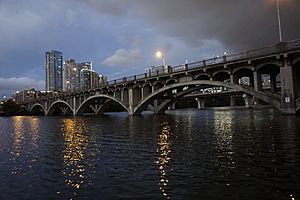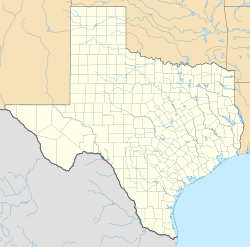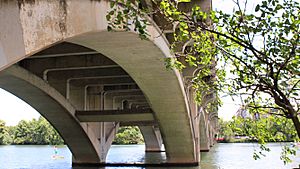Lamar Boulevard Bridge facts for kids
Quick facts for kids Lamar Boulevard Bridge |
|
|---|---|

Lamar Boulevard Bridge over Lady Bird Lake, viewed from the southwest
|
|
| Carries | |
| Crosses | Lady Bird Lake (Colorado River) |
| Locale | Austin, Texas United States |
| Owner | State of Texas |
| ID number | 142270011312065 |
| Characteristics | |
| Design | Arch bridge |
| Material | Reinforced concrete |
| Total length | 659 feet (201 m) |
| Width | 49 feet (15 m) |
| Longest span | 110 feet (34 m) |
| Number of spans | 6 |
| Piers in water | 5 |
| History | |
| Architect | Cage Brothers and L. A. Turner |
| Construction begin | March 27, 1941 |
| Construction cost | $303,900 |
| Opened | July 15, 1942 |
|
Lamar Boulevard Bridge
|
|
| Architectural style | Art Deco |
| NRHP reference No. | 94000678 |
| Added to NRHP | July 7, 1994 |
The Lamar Boulevard Bridge is a famous arch bridge in Austin, Texas, United States. It carries Texas State Highway Loop 343 (Lamar Boulevard) over Lady Bird Lake, which is part of the Colorado River. This bridge is a big part of Austin's history and helps thousands of cars cross the lake every day. It was finished in 1942 and is known for its cool Art Deco style. It's so important that it was named an Austin Landmark in 1993 and added to the National Register of Historic Places in 1994.
Contents
A Bridge Through Time
In the late 1930s, Austin was growing fast, especially on the north side of the Colorado River. The city needed a new main road to connect its western neighborhoods. This new road, called Lamar Boulevard, would run near Shoal Creek and reach the river.
On the south side of the river, the road would link up with what was then Texas State Highway 20. The Texas Highway Department (now called the Texas Department of Transportation) was in charge of building a bridge for this new road.
Building the Bridge
Construction on the Lamar Boulevard Bridge began on March 27, 1941. It cost about $303,900 to build. The bridge was finished and opened for traffic on July 15, 1942.
When it first opened, the bridge didn't have street lights. This might have been because of shortages during World War II. Lights were added later in 1955.
In 1960, the Longhorn Dam was built. This turned the river under the bridge into Town Lake, which is now known as Lady Bird Lake. The water level rose to just below the bridge's arches.
A Protected View
In 1983, the view of the Texas State Capitol from the bridge became a "Capitol View Corridor." This means state and local laws protect this view from being blocked by tall buildings.
On July 7, 1994, the bridge was added to the National Register of Historic Places. This recognized its special design and how important it is for Austin's transportation. Today, the bridge still carries Lamar Boulevard and handles a lot of cars and people every day.
Adding a Pedestrian Bridge
The original Lamar Boulevard Bridge was built without special lanes for bikes and had narrow sidewalks. These sidewalks were only separated from the road by small curbs. In the 1990s, this area became known for accidents involving cyclists and people walking.
The City of Austin wanted to make the bridge wider for people and bikes. However, the Texas Historical Commission didn't want to change the bridge's historic design. This led to a new plan in 2001. A separate bridge, the James D. Pfluger Pedestrian and Bicycle Bridge, was built about 200 feet (61 m) east of the Lamar bridge. This new bridge provides a safe path for walkers and bikers.
Bridge Design
The Lamar Boulevard Bridge is an arch bridge made of reinforced concrete. It crosses the Colorado River with six identical spans, each about 110 feet (34 m) long. These spans are held up by five concrete piers in the river and concrete supports called abutments at each end.
The top part of the bridge, called the deck, has four lanes for cars. On each side, there's a sidewalk and a metal balustrade (a fancy railing). The piers and railings have Art Deco details, like vertical grooves called fluting. These details show the style of the time when the bridge was built.
The piers sit on strong foundations made of limestone bedrock. Each span has two parallel concrete arch ribs. These ribs are about 8.5 feet (2.6 m) wide and 2.25 feet (0.69 m) thick. They rise to about 19 feet (5.8 m) above the base of the arch.
Thin vertical columns rise from the arches to support smaller arches and beams right under the deck. These beams extend out about 7 feet (2.1 m) to support the sidewalks and railings.
The railings on the parts of the road leading to the bridge are solid concrete. On the bridge deck itself, the railings are made of steel tubes with vertical steel bars. These are supported by concrete columns. Eight of these columns are on each span, with taller, stronger columns above the piers that hold the street lights.



